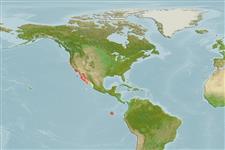Preferred temperature (Ref.
123201): 12.4 - 23, mean 20.6 °C (based on 34 cells).
Phylogenetic diversity index (Ref.
82804): PD
50 = 0.5002 [Uniqueness, from 0.5 = low to 2.0 = high].
Bayesian length-weight: a=0.00389 (0.00123 - 0.01235), b=3.08 (2.82 - 3.34), in cm total length, based on LWR estimates for this (Sub)family-body shape (Ref.
93245).
ระดับชั้นอาหาร (Ref.
69278): 3.2 ±0.1 se; based on diet studies.
ความสามารถในการกลับคืนสู่ปกติ (Ref.
120179): ต่ำ, เวลาต่ำสุดที่จะทำให้ประชากรเพิ่มขึ้นเป็น 2 เท่าใช้เวลา 4.5 - 14 ปี (tm=3; tmax=23; k=0.09-0.22).
Fishing Vulnerability (Ref.
59153): Very high vulnerability (75 of 100).
Nutrients (Ref.
124155): Calcium = 8.59 [1.10, 170.56] mg/100g; Iron = 0.647 [0.059, 7.948] mg/100g; Protein = 20.5 [15.2, 25.6] %; Omega3 = 0.159 [0.050, 0.437] g/100g; Selenium = 28.9 [5.9, 146.1] μg/100g; VitaminA = 3.22 [0.27, 34.64] μg/100g; Zinc = 0.476 [0.031, 5.520] mg/100g (wet weight);
